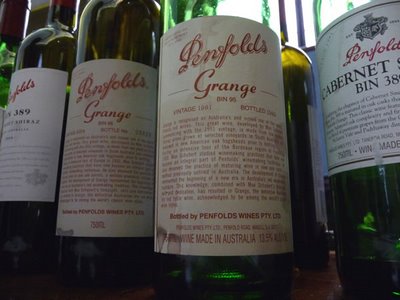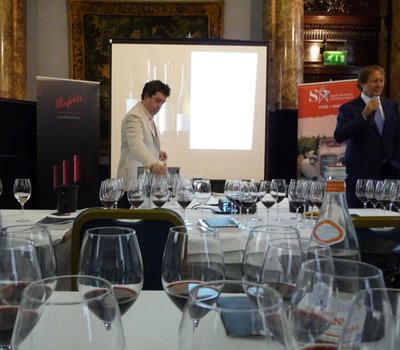Grange versus Bin 389, a masterclass
 Very interesting tasting this afternoon. It was held at Australia House (where they have the annoying rule that if the invitation says 3.30 pm, you aren't even allowed in the building until 3.30 pm), and it involved a vertical of two Penfolds wines: the iconic Grange, and its sibling the Bin 389. There was a good turnout, including cricketing legend Ian Botham.
Very interesting tasting this afternoon. It was held at Australia House (where they have the annoying rule that if the invitation says 3.30 pm, you aren't even allowed in the building until 3.30 pm), and it involved a vertical of two Penfolds wines: the iconic Grange, and its sibling the Bin 389. There was a good turnout, including cricketing legend Ian Botham.Peter Gago presented, and did a very good job in keeping the tasting moving. But when he took questions, he simply avoided answering mine by being horridly, politician-level evasive - I'd asked him about the extent and timing of additions of acid and tannin. His response was that they didn't add tannins, but did tannin finings, and talked about all the other finings that they don't use. He said that they added grape-derived tartaric acid 'which all falls out anyway', and that they have a Barossa Sangiovese which they didn't add any acid to at all.

But it's the wines we were there for, and they were lovely. Penfolds have a distinctive, instantly recognizable house style. Grange is an icon and lasts for ever, as the 1955 and 1971 we enjoyed at the Landmark Tutorial showed. [It's probably partly because of the addition of acid -totally normal in Australia - and tannin that the wines live so long.]
Bin 389 is underrated. It's a great, ageworthy wine in its own right. 1986 389 was fading but complex (not the best bottle, apparently), 1990 was beautiful with lovely pure fruit, 1991 almost as good but more woody, 1996 was weaker, 1998 fantastically fruity and 2004 was brilliantly intense.
As for Grange? 1986 was brilliant, 1990 and 1991 both fantastic but rather different in style, 1996 was very good but has sticky out acid, 1998 was a backward classic, and 2004 was in a league of its own - a truly great Grange with amazingly intense fruit, great focus and real complexity. It's horribly expensive, but a really special wine. Gago and his team truly are custodians of a national treasure.


11 Comments:
Gago should have been a politician...
I know what you mean, Jamie, I always find myself somewhat unsatisfied when he answers a question.
Not only am I jealous ... now I have to go & investigate tannin finings ...
Doesn't it seem that the addition of acid and tannins to a wine somehow takes away from its authenticity, and would make it seem more manufactured?
I'm sure these wines taste amazing (never had them myself) though.
Where can I read more about this practice? Does it happen often in other regions, both old and new world?
Another in the Penfolds family worth trying is RWT (origins as "Red Winemaking Trial", I believe). It is nowhere near as expensive as the Grange, but it is still pretty pricey. John in Budapest
Added acids are the industry norm down under, so no surprises there, but even with Grange? This bothers me.
To me it seems they've build their own version St Peters out of plastic: lovely architecture and undeniable grandness with a few shortcuts:)
California is allowed to add water to their ferments, Germany is allowed to add sugar, and so on. There are lots of 'additions' and manipulations of wine that go on everywhere.
Now, lets not even touch on reverse osmosis in Bordeaux! :-)
If someones doing it, it's gotta be OK, and "we don't do nuances", as that one dude proudly stated in the midst of all the awkward stuff.
Is there really no way to reach even a half-baked consensus on the theoretical concept of "quality wine"? The industrial low-end stuff aside, should anything go since 'Zi Zermans' are doin' it? ;)
ps. Adding sugar's not allowed on quality stuff in Germany and the Mox and the reverse osmosis in Bordeaux, pheew, let's not go there (though we should):)
Jamie, so 389 is about £20 grange £150. Which one are you buying?
Russ
My understanding is that in France, by and large, acid addition or chaptalisation is okay - but not both simultaneously. As a little bit of an aside, for me there's a difference between taking something out (R.O.) and putting something in. As far as adding acid, something that should be kept in mind is that if you're serious about avoiding Brett or other taints, it really doesn't hurt to keep your pH low - and so in a country like Australia where pH tends higher, it's important for winemakers for reasons other than simple palatability.
@John in Budapest: have you tried the 2005 RWT, which is available in Budapest? I'd like to taste a serious Penfolds, but I don't know if RWT is worth the extra money over Magill '05 or St Henri '04... any help appreciated.
Post a Comment
Links to this post:
Create a Link
<< Home